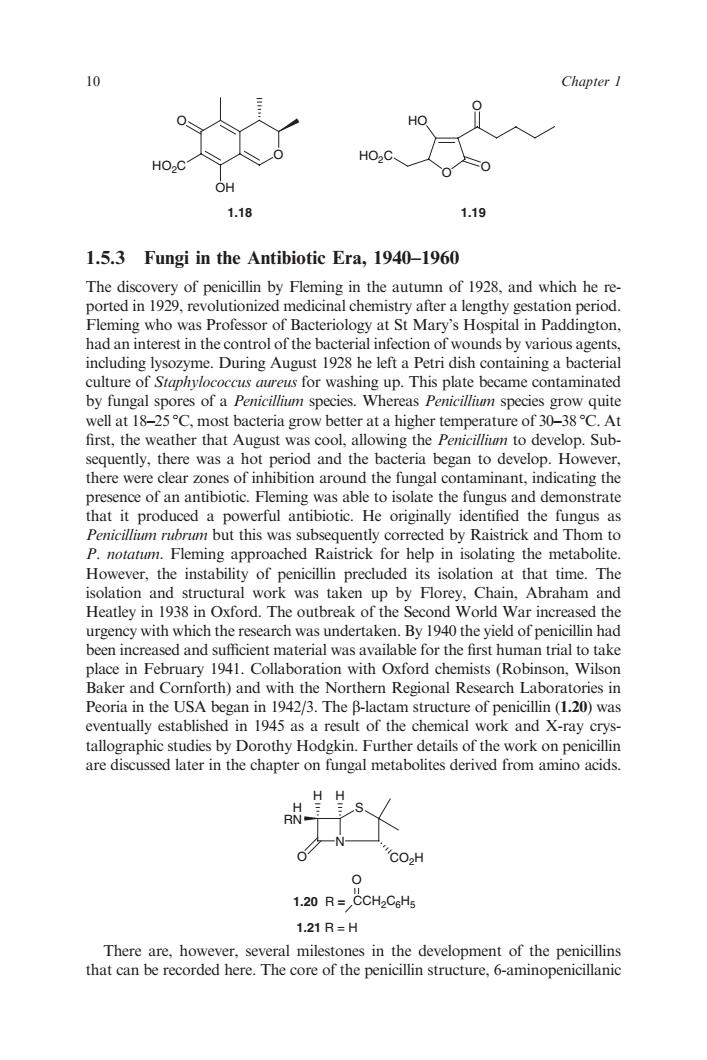正在加载图片...

0 Chapter HO2C. 1.18 1.19 1.5.3 Fungi in the Antibiotic Era,1940-1960 The discovery of penicillin by Fleming in the autumn of 1928,and which he re che r a le atio tSt Mary's Hos nfection of wounds by various agents including lysozyme.During August 1928 he left a Petri dish containing a bacterial culture of Staphylococcus aureus for washing up.This plate became contaminated by fungal spores of a Penicillium species.Whereas Penicillit species grow quite well at 18-25C,most bacteria grow better at a higher temperature of 30-38C.At first,the weather that August was cool,allowing the Penicillitmn to develop.Sub ntly,there was a hot period and the bacte ri bega an to develop.Howe there were clear of inh ibition around thef ung nant,indicating th pre ice of the fung demonstrate that it produced a powerful antibiotic. the fungus as Penicillium rubrum but this was subsequently corrected by Raistrick and Thom to P.notatin.Fleming approached Raistrick for help in isolating the metabolite. However.the instability of penicillin precluded its isolation at that time.The isolation and structural work was taken up by florey.Chain.Abraham and Heatley in 1938 in Oxford.The outbreak of the Second World War increased the ndertake By 1940 the d and suf yield of penicillin had ten was for the f place in February 1941 ation with Oxfor rd che trial to emists(R Baker and Cornforth)and with the Northern Regional Research Labora ones i Peoria in the USA began in 1942/3.The B-lactam structure of penicillin(1.20)was eventually established in 1945 as a result of the chemical work and X-ray crys- tallographic studies by Dorothy Hodgkin.Further details of the work on penicillin are discussed later in the chapter on fungal metabolites derived from amino acids. 1.20 R=CCH2CaHg 1.21R=H There are,however,several milestones in the development of the penicillins that can be recorded here.The core of the penicillin structure,6-aminopenicillanicO O HO2C OH 1.18 O HO O O HO2C 1.19 1.5.3 Fungi in the Antibiotic Era, 1940–1960 The discovery of penicillin by Fleming in the autumn of 1928, and which he reported in 1929, revolutionized medicinal chemistry after a lengthy gestation period. Fleming who was Professor of Bacteriology at St Mary’s Hospital in Paddington, had an interest in the control of the bacterial infection of wounds by various agents, including lysozyme. During August 1928 he left a Petri dish containing a bacterial culture of Staphylococcus aureus for washing up. This plate became contaminated by fungal spores of a Penicillium species. Whereas Penicillium species grow quite well at 18–25 1C, most bacteria grow better at a higher temperature of 30–38 1C. At first, the weather that August was cool, allowing the Penicillium to develop. Subsequently, there was a hot period and the bacteria began to develop. However, there were clear zones of inhibition around the fungal contaminant, indicating the presence of an antibiotic. Fleming was able to isolate the fungus and demonstrate that it produced a powerful antibiotic. He originally identified the fungus as Penicillium rubrum but this was subsequently corrected by Raistrick and Thom to P. notatum. Fleming approached Raistrick for help in isolating the metabolite. However, the instability of penicillin precluded its isolation at that time. The isolation and structural work was taken up by Florey, Chain, Abraham and Heatley in 1938 in Oxford. The outbreak of the Second World War increased the urgency with which the research was undertaken. By 1940 the yield of penicillin had been increased and sufficient material was available for the first human trial to take place in February 1941. Collaboration with Oxford chemists (Robinson, Wilson Baker and Cornforth) and with the Northern Regional Research Laboratories in Peoria in the USA began in 1942/3. The b-lactam structure of penicillin (1.20) was eventually established in 1945 as a result of the chemical work and X-ray crystallographic studies by Dorothy Hodgkin. Further details of the work on penicillin are discussed later in the chapter on fungal metabolites derived from amino acids. N S O H H CO2H RN H 1.20 R = 1.21 R = H CCH2C6H5 O There are, however, several milestones in the development of the penicillins that can be recorded here. The core of the penicillin structure, 6-aminopenicillanic 10 Chapter 1